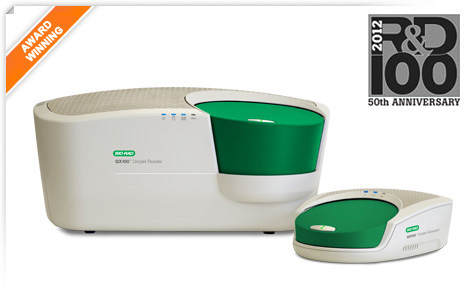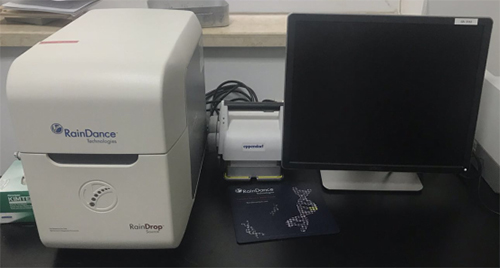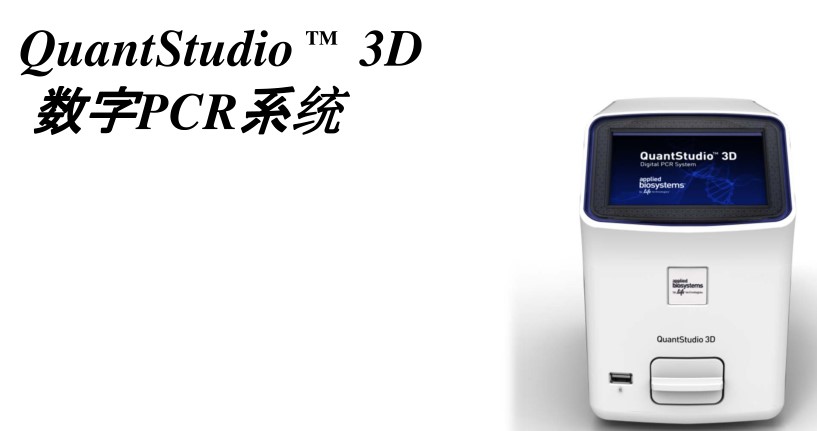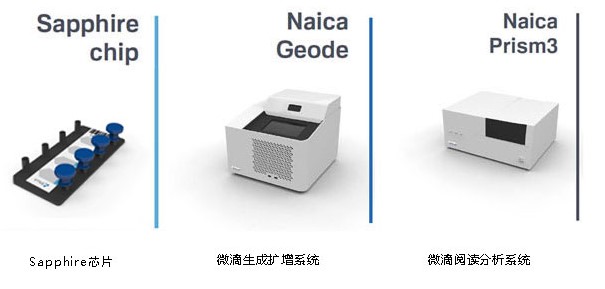博文
数字PCR简介
|||
1985年美国科学家Kary Mullis发明PCR方法以后,PCR已经成为生命科学研究领域中最常规的实验方法之一。PCR是用于放大扩增特定的DNA片段的分子生物学技术,可看作是生物体外的特殊DNA复制。PCR的最大特点,是能将微量DNA大量扩增。
最传统的一代PCR采用琼脂糖电泳的方式对PCR产物进行分析,操作繁琐、难于做定量分析。为使PCR技术能对基因水平进行定量分析,1992年开发了荧光实时定量PCR(二代PCR)。实时定量PCR(qPCR)通常在DNA扩增时对反应体系中的荧光信号进行实时收集,通过三个参数间(荧光信号-Cq值(罗氏公司)或Ct值(ABI公司)-靶基因的起始浓度)的关系,能以相对定量的方式确定靶基因的拷贝数或推断基因表达水平。由于荧光定量PCR的分析是相对定量的方式,这也是目前荧光定量PCR的最大技术缺点。在低拷贝靶分子、模板浓度差异的条件下,其检测灵敏度、精确度都受到了限制。
1999年霍普金斯大学的Vogelstein教授首先提出了第三代的Digital PCR(数字PCR)的概念。此后数字PCR技术得到迅速的发展。数字PCR是一种核酸检测和绝对定量的新方法。同传统PCR相比,数字PCR增加了一步分隔(partitioning)的操作,将几十微升的反应体系分隔成了众多微小独立反应体系。核酸模板在这种分割过程中被充分稀释,理想状态下每个微反应体系中至多含有1个分子的核酸模板。和qPCR不同,数字PCR不对扩增过程进行实时监测,而是检测end-point的荧光信号。扩增完成后所有液滴的荧光将逐个被识别并进行计数,不需要构建标准曲线,就可以得到绝对定量的结果。
目前数字PCR的主要产品有:
1. QX200

QX200目前已经是Bio-Rad的产品。Bio-Rad的技术主要来源于QuantaLife公司,QuantaLife 利用油包水微滴生成技术开发了微滴式数字ddPCR,这是最早出现的相对成熟的数字PCR平台,在运行成本和实验结果稳定性方面都基本达到了商品化的标准。 2011年QuantaLife 公司被Bio-Rad公司收购,其微滴式数字PCR仪产品更名为QX100,继续在市场上销售,2013年该公司又推出了升级型号QX200。
2. Raindrop

Raindrop数字PCR是美国RainDance Technologies公司于2012年推出的产品。能够提供更高的检测范围,适用于处理更大浓度差异的不同样品,这个设备将其原有的二代测序文库制备平台技术也整合进入数字PCR技术平台,在高压气体驱动下,将每个标准反应体系分割成100万至1000万个P升级微滴反应乳液,这种超高的微滴数目可以为用户“提供更高的检测动态范围,适用于处理更大浓度差异的不同样品。在2017年Bio-Rad完成了对RainDance公司的收购。
3. Quant Studio 3D

Applied Biosystems公司2013年也推出了Quant Studio 3D数字PCR系统,是目前数字PCR市场上新型号产品之一。采用高密度流控芯片技术,使样本均匀分配至20,000个单独的反应孔中。在整个测定流程中,样本之间保持完全隔离,防止样品交叉污染。移液过程和操作步骤减少。芯片式设计避免了微滴式系统可能出现的管路堵塞问题。Applied Biosystems在OpenArray芯片平台之外推出的全新的芯片式数字PCR系统,这个全新系统在设计上综合考虑了系统稳定性与运行成本因素。 2013年Thermo Fisher公司收购了Applied Biosystems。
Quant Studio 3D 数字PCR可用于分子标准品定量;原体检测和定量测定;罕见癌症基因突变检测;拷贝数变异分析;GMO检测和污染评估;mRNA 和miRNA表达低倍变化的确定等。
4. Naica TM crystal

Naica™ crystal数字PCR系统是由法国Stilla Technologies公司推出的产品。将微滴均匀性和芯片可视化以及相同PCR反应条件创新性集成在同一系统中,使用微流体创新型Sapphire芯片,样品通过毛细通道网格以30,000个Crystal微滴的形式进入发布在2D芯片中。 这种方法在满足实验室对数据精准性、重复性要求的同时,让数字PCR分子检测变得更加简单快捷。PCR扩增过程在芯片上实现。最终对阳性微滴计数从而得到精准的核酸绝对数量。作为首款三个荧光通道检测的数字PCR平台,Naica™ crystal数字PCR系统可在2小时内实现多达36个目标基因的检测。Naica™ Crystal系统由Geode微滴生成;扩增仪和Prism3微滴阅读分析系统组成,仅需唯一耗材——Sapphire芯片,即可完成从加样、微滴生成和扩增,直到采集数据获得结果。 Naica™ crystal数字PCR可用于:基因表达差异检测;拷贝数变异(CNV);低丰度及稀有序列的精确定量;甲基化含量鉴定;肿瘤治疗的伴随诊断;无创产前筛查;病原微生物的检测(病毒、细菌等);二代测序辅助建库;肿瘤治疗的实时监控 (ctDNA检测)等。
ReaserchGate 论坛对digital PCR不同品牌比较的讨论:
David Otaegui Biodonostia Institute 6th Jun, 2014 :Digital PCR, Qx200 vs Quantstudio 3D; Which one you think is the best?
Eric Ouellet University of British Columbia – Vancouver 7th Jul, 2014:Hi David, Our lab uses a QX100 ddPCR platform from Bio-Rad (now QX200). At the time it was the only available option. However, I can offer some advice on its usability. As you may know, bio-rad uses droplets to perform ddPCR, a process on which they are continuously improving upon. The new cartridge designs can, in our experience, reliably and reproducibly partition samples. Although the process is more labor-intensive (and to some extent, more prone to user error), we did welcome the added flexibility of using such a system.
The Quantstudio 3D instrument is a bit reminiscent of the platform pioneered by Fluidigm. In these case, the partition is done geographically. In many cases, the yes/no readouts are sufficient, but in cases where samples would need to be recovered, these platforms would have great difficulty in achieving this, compared to emulsion-based systems. However, for most clinical applications, these instruments are often very useful.
Raindance is also another promising company that is currently trying to enter the market of droplet-based digital PCR detection, although they currently offer fee-per-service options rather than instruments themselves. However, according to their documentation, they can achieve partition levels that dwarf the other platforms, providing there is a need for such high levels.
The other aspects to consider are not only the capabilities of these various systems, but perhaps more importantly, the cost of the consumables and reagents, especially when compared to NGS platforms that are constantly becoming more affordable.
Ultimately, the balance between flexibility and ease-of-use would have to be weighed for any particular application. In our case, we required the flexibility, albeit a steeper learning curve.
Giovanni Lopez Universidad Peruana Cayetano Heredia 2nd Feb, 2015:Here in South America QX200 this $180456....Includes only: A reader Droplet oil (1863004), a droplet generation oil (186305),Buffer 2X Control Kit (1863052),ddPCR Supermix 2X (1863010). What is it that more is spent?
Rupesh Deshmukh Laval University 12th Dec, 2016:Can anyone provide me cost comparison between QX200 and Quantstudio 3D.Thanks
Kevin Kelly Thermo Fisher Scientific 7th Jul, 2017:Hi Rupesh, The QS3D costs around half of what the Bio-Rad system costs. If you'd like more info send me a message at kevin.f.kelly@thermofisher.com, and I'd be happy to connect you with your local sales rep for additional information. Thanks, Kevin
David Dobnik Nacionalni inštitut za biologijo 9th Sept, 2017:Hi David, In our lab we have two Bio-Rad's machines (QX100 and 200) a Fluidigm Biomark HD and have also had the chance to test Quantstudio 3D and Stilla's Naica platform. Overall, regarding the usability and throughput, the Bio-Rad's system is the one I prefer. We have tested duplex assays on QX100 and QS3D side by side and separation of clusters on QS3D was rather poor. However, if you do not plan to run a lot of samples per run, even QS3D might be a good choice looking from the cost perspective.
Oliver Schultz Stilla Technologies 4th Apr, 2018:Dear network, if you′re interested in an innovative & new approach to digital droplet PCR, please check out the NAICA system from STILLA Technologies. It′s the fastest system on the market, including a 3-color detection and the capability of recovering the droplets after read-out for downstream applications. Learn more at www.stillatechnologies.com Best wishes, Oliver
Minka Kovač Omega 8th Aug, 2018:Dear all, in our lab we have a Quantstudio3D. We know also other platforms like BioRad, Stilla, Fluidigm and QuantStudio 12 Flex with Open Array. Honestly speaking if you have a small number of samples per day, less than 96 per day the platform for you is QST3D. Price performance for small amount of samples is strongly on QST3d side (price of the instrument, price per reaction). Second majority of assay's from ABI now Thermo Fisher Scientific works well with no additional optimization, like 90 -95 %. But yes, sometimes for some assays additional optimization is a MUST. So regarding the Quality of the data from results between QST3D and BioRad (others as well) I have to say that data is dependent on the fine optimization. You can even find the scientific articles which showed that systems on the digital market are more or less comparable. The entering price of the QST3D instrument is more than half lower compared to the BioRad droplet platform. If you have more than 96 samples per day or ca 10000 samples yearly you have to think about bigger systems (Stilla, BioRad, OpenArray) Best wishes, Minka
https://blog.sciencenet.cn/blog-3302154-1185122.html
上一篇:患者个人空间对临床医生的意义
下一篇:返还丢失的钱包